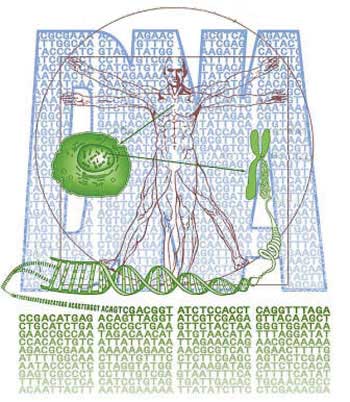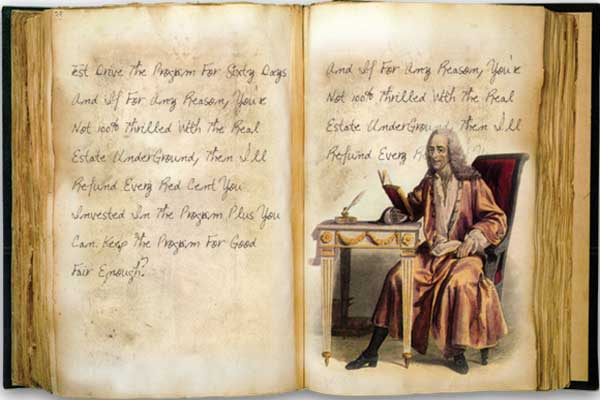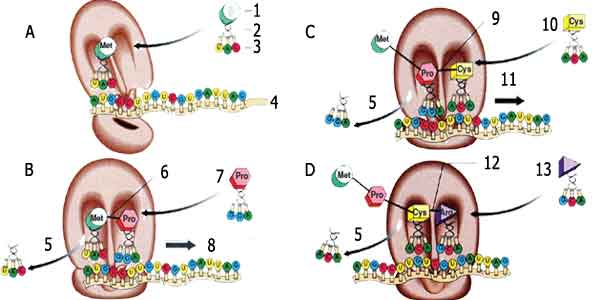The Cryptography in the DNA Molecule
In every cell in your body lies a glorious treasure house of information, written in a language spoken by nobody on Earth,. The alphabet of this language consists of just four letters, and each letter stands for a chemical molecule known as a base or nucleotide. The genetic "words" known as codons are made up of these letters. This DNA language of just four letters consists of the molecules adenine, thymine, guanine and cytosine, or the letters A, T, G and C for short. All the information contained in the data bank within the nucleus is encoded in this four-letter alphabet. When hundreds of the letters A, T, G and C are taken together, the result is long, meaningful "sentences" known as genes, which describe how the processes in the body should take place and give instructions regarding them. Millions of these "letters" set out in a meaningful sequence one after the other comprise the DNA molecule. In his book Our Molecular Nature, the molecular biologist David S. Goodsell refers to the DNA molecule as. . . perhaps the most beautiful of our molecules, but like a fine book, its true beauty lies not in binding, but in the words written within.66
All of a person's physical characteristics have been encoded by means of this special language and stored in the cell nucleus. An organism's body shape, the vital functions of all its organs and the organization of how those organs function, the genetic codes and amounts of proteins that need to be produced within the cell are all encoded in DNA. This enormous code contains information about a person's entire body, ever since it was no more than a single cell. To put it another way, before the individual even became a human being, a comprehensive blueprint for the entire body was ready in a single molecule.
When referring to the nucleic acids that make up DNA in the cell nucleus, we shall continue to use the letter analogy. These letters, as we explained earlier, come together in specific pairs to form the "steps" on the staircase. By being added one on top the next, these steps then constitute genes. Every gene in part of the DNA molecule controls specific human features. Height, eye color, the structure of the nose, ears and skull, and countless other characteristics all come into being by the commands of relevant genes. We may compare these genes to the pages of a book written with only the letters A, T, G and C.
There are some 30,000 genes in a human cell's DNA. Every gene consists of between 1,000 and 186,000 nucleotides arranged in a particular sequence, depending on the kind of protein to which it corresponds. These genes contain the codes for some 200,000 proteins that operate inside the human body, and also regulate the production of those same proteins. The information contained by these 30,000 genes represents only 3% of the total information that DNA contains. The data in the remaining 97% is still unknown, but it has been established that this portion contains information essential to the activities of the cell. (For more detail, see the Chapter 12, "How the Miracle of DNA Invalidates the Theory of Evolution.")
Genes exist inside chromosomes, and there are 46 chromosomes in the nucleus of every human cell (apart from the reproductive cells). To compare every chromosome to a volume consisting of pages in the form of genes, then we can say that in each cell, there is a 46-volume cellular encyclopedia containing all of a human being's characteristics. As we've already made clear, this cellular encyclopedia contains an amount of information equivalent to a 920-volume Encyclopedia Britannica.
The arrangement of the letters in every individual's DNA is different. That is why all the people who have ever lived have been different from one another. The basic structure and functions of the organs are the same in everyone. Yet everyone is specially created with such fine differences and in such a detailed manner that although all human beings develop the same basic structure through the division of a single cell, the result is still billions of people with wholly different appearances.
The arrangement of the letters in DNA determines a person's characteristics, right down to the tiniest details. In addition to features such as height and the colors of one's eye, hair and skin color, blueprints for the 206 bones in the body, 600 muscles, a 10,000-component network of hearing nerves, 2 million-part network of optic nerves, 100 billion nerve cells, blood vessels 130,000,000,000 meters (80,780,000 miles) in length and 100 trillion cells all exist in the DNA in a single cell. The Canadian science writer Denyse O'Leary refers to the information in DNA:
The truly puzzling type of information is the type that is characteristics of human artifacts, and is also written in our DNA. It does not follow a repetitive pattern. But it has a pattern that relates it to other information and it is complex. For example, the DNA in a cat embryo is a complex series of instructions for a kitten that the embryo is carrying out.67
Since not even a single word cannot form in the absence of a writer, how did the billions of "letters" in the human genome come into existence? How have these letters been arranged in a meaningful way to constitute the matchless blueprint for such perfect and complex bodies? The slightest alteration to the arrangement of these letters could lead to us having fingers on our feet, eyes in our stomachs or heads facing backwards. Our arms might be longer or shorter than they actually are, or our lips might be sealed together. If we currently exist as normal human beings, that is only through the permission of our Almighty Lord. Allah has made the arrangement in the letters in every human being's DNA the means whereby this comes about. In one verse, He informs us that:
He is Allah-the Creator, the Maker, the Giver of Form. To Him belong the Most Beautiful Names. Everything in the heavens and Earth glorifies Him. He is the Almighty, the All-Wise. (Surat al-Hashr, 24)
The DNA Molecule Contains Coded Messages
 |
The sublime creation inside the DNA molecule is able to carry the specific arrangement of its own atoms and the maximum amount of code in the minimum area. Every letter that constitutes this genetic code is written into the cell nucleus by means of a molecule with its own particular chemical features and three-dimensional structure. Arthur Ernest Wilder-Smith, a professor of chemistry, refers to the message in the DNA molecule in one of his books:
All biological cells are guided by program stored in the cell nucleus on DNA molecules in code form. . . all cellular syntheses and catabolic processes are teleonomically remotely controlled by the coded program in the nucleus . . . In order to avoid the lengthy explanations necessary to clarify such a system theoretically, we shall describe the major traits of the genetic code system with the aid of several simple analogies. The internationally recognized distress call is "S O S." This call contains information within a coded phrase, which may also be expressed as: . . . - - -. . . The dots and dashes represent the two letters of Morse code. . . . is equivalent to our letter "S" and - - - to our "O." We can store or transmit the Morse alphabet in various manners. For example, the letters can be retained on paper, written on a birthday cake with cake icing, or an airplane could write [them]. The message and the information remain the same, namely "S O S," in whatever medium they are transmitted or stored. The dots and dashes of the Morse code might even be knotted on a string, the dash being represented as a larger knot and the dot as a smaller knot. In this last case, no paper surface is required to relay the message contained in the Morse code, the dimension of only a simple piece of string will suffice. By means of a system of this type. a string carrying single knots and double knots (= dashes) could be used to "write" and to store Goethe's Faust. 68
As set out above, the information content is independent of its mode of transmission. Therefore, not just the arrangement of the bases in the DNA, but also the coded information, the message that it contains, is noteworthy. The science writer Richard Milton highlights the delicate organization in the coding of messages in DNA:
Each instruction in a program must be carefully considered by the programmer as to both its immediate effect on the computer hardware and its effects on other parts of the program. The letters and numbers which the programmer uses to write the instructions have to be written down with absolute precision with regard to the vocabulary and syntax of the programming language he uses in order for the computer system to function at all. Even the most trivial error can lead to a complete malfunction. In 1977, for example, an attempt by NASA to launch a weather satellite from Cape Canaveral ended in disaster when the launch vehicle went off course shortly after takeoff and had to be destroyed. Subsequent investigation by NASA engineers found that the accident was caused by failure of the onboard computer guidance system-because a single comma had been misplaced in the guidance program. Anyone who has programmed a computer to perform the simplest task in the simplest language –Basic, for instance– will understand the problem. If you make the simplest error in syntax, misplacing a letter, a punctuation mark or even a space, the program will not run at all. In just the same way, each nucleotide has to be "written" in precisely the correct order and in precisely the correct location in the DNA molecule for the offspring to remain viable and, as described earlier, major functional disorders in humans, animals, and plants are caused by the loss or displacement of a single DNA molecule, or even a single nucleotide within that molecule.69
 | |
| 1- 1 Nm: 1 Nanometer (1 millionth of a millimeteri), | 5- extended chromosome, |
| The unique arrangement of the atoms in the DNA molecule has a sublime creation capable of carrying the maximum amount of information in the minimum amount of space. | |
Professor Murray Eden is an expert from the Massachusetts Institute of Technology on the subject of information theory and official languages. He says that "No currently existing formal language can tolerate random changes in the symbol sequences which express its sentences. Meaning is almost invariably destroyed. Any changes must be syntactically lawful ones."70 He goes on to state that this rule also applies to the language of DNA that constitutes genetic information.
All these statements show that the information in DNA could not possibly have emerged as the result of chance. In the face of these fictitious claims made by evolutionists, we may cite the mathematical science of coding information to ensure its security, known as cryptology. One aim of this science is let information be read accurately and prevent its being altered. For example, a hacker monitoring the communication between two individuals on the Internet, may make changes to the information they send to one another. Thus the preservation of original information is of great importance. The greater the importance of the information, the greater the importance and difficulty of the coding technique to be employed. That is why special programs prevent information being readily accessible to just anyone. Only specific authorized individuals can read and alter this program's information, whose accuracy is confirmed by means of security systems.
Since genetic information is of direct importance to human life, it too must not be subjected to any alteration. Only within the last 50 years did scientists discover that such an important treasure store of information was concealed inside the cell, but this priceless information has been protected inside the cell nucleus, using a special code, ever since human beings were first created. Every detail regarding this molecule is full of examples of Allah's sublime creation. DNA prompts us to ask the following questions:
- Who possesses the information needed to construct a perfect body?
- Who conceals that information inside living tissue?
- Who compresses such wide-ranging information into such a minute space, and how?
- Who knows how very important this information is and maintains it under protection?
- Who encodes the information and who deciphers it?
- Who ensures that there are no deficiencies or impairments during the deciphering process?
- Who knows that this information must be transmitted to future generations and knows the technique to employ in doing so?
- Who copies this information into new cells as they are renewed and multiply, and how?
These questions, to which hundreds more could be added, lead us to the existence of our omniscient, sublimely intelligent Creator. DNA is "...the handiwork of Allah Who gives to everything its solidity..." (Surat an-Naml, 88) In the Qur'an, Allah reveals the organization in His creation:
O man! What has deluded you in respect of your Noble Lord? He Who created you and formed you and proportioned you and assembled you in whatever way He willed. (Surat al-Infitar, 6-8)
| The Great Store of Data in DNA cannot Be Explained by Fictitious Claims of Evolution |
| The DNA molecule is a manual that needs to be read by every living thing on Earth. Neither animal, nor plant nor human life would be possible in the absence of that information. Your arms and legs, the structure of the eye, the working of your brain, the harmony between your coronary and circulatory systems, and your entire immune system become functional by using the data stored inside DNA. Therefore, in order for any living thing to exist, its DNA molecules must exist, too. There can be no question of a penguin, a cat or a fish without DNA in each of its cells. This data store, directing all the body's activities over the course of its entire life, must have been installed inside cells ever since the moment when life was first created. The slow, gradual development maintained by the theory of evolution is out of the question. The data store in the DNA molecule is an evident proof of the mercy of Allah manifested in human beings and in the world. Our Almighty Lord best knows the needs of all living things. In one verse of the Qur'an it is revealed: … He has most knowledge of you when He first produced you from the earth, and when you were embryos in your mothers' wombs. So do not claim purity for yourselves. He knows best those who guard against evil. (Surat an-Najm, 32) |
 |
| In the Presence of a Book, |
| Whenever any written work is presented, the question arises: Who is the author who discovered the information in it? It is impossible to claim that a fascinating, intricate, world-renowned manual was written spontaneously or came into being as the result of chance. Everyone will agree that every word and every line was written by some author. The store of information in the DNA, kept under special protection in the cell nucleus, also has a Lord and Creator. In one verse of the Qur'an we are told: "It is He Who brought you into being and gave you hearing, sight and hearts. What little thanks you show!" (Surat al-Mulk, 23) and that it is Allah Who creates and gives human beings all their characteristics. |
In order to write a work about what is needed for all of an organism's bodily functions, the author must know all the details about that organism's cellular activities will be performed at the atomic and molecular level and to accurately determine its special requirements at every stage of life, from infancy right up to death. Only our Lord knows all this information and "proportioned" humankind. (Surah 'Abasa, 19)
In addition, all other living things on Earth –bacteria, viruses, insects, horses and plants– also have DNA in their cells. Each one's DNA contains detailed information about the needs and body structure of the organism to which it belongs. Recalling the millions of species on Earth, one can better grasp the scope of the information in question. Our Almighty Lord equips every living thing right from the outset with all the information it needs, places that information inside the cells, and creates the separate DNA sequences for each living species.
The Translation From DNA's Four Letters into a 20-Letter Protein
As you saw in earlier sections of this book, the data bank inside the DNA has been encoded in the form of four chemical bases represented by the letters A, T, G and C. But for this 4-letter DNA language to be used, it must be translated into a 20-letter protein language. The information in DNA becomes meaningful for proteins only as a result of this translation process. The well-known chemist Prof. Wilder Smith notes the difficult nature of a system able to translate between these two languages:
Translation of information from one language into another constitutes one of the most difficult tasks which can be presented to a computer. The computer must be fed very carefully with extensive and highly complicated programs, if it is to carry out the translation satisfactorily. Americans have spent millions of dollars in the attempt to obtain machine translations from Russian into English automatically from computers. After more than twenty years of work, there still exists no machine which is capable of independently translating idiomatic Russian into idiomatic English without being constantly checked by a good interpreter who continually supervises the machine's work. The mechanized translation of idioms from one language to another is so difficult that preprogramming of the machine seldom suffices.71
| The Variety Arising from Four "Letters" is a Miracle of Creation | ||
 | ||
| 1. Methionine (Amino Acid) | 6. A peptide bond forms. | 10. Cysteine (Amino Acid) |
| The DNA molecule, found in every one of the 100 trillion cells in the body, contains a flawless blueprint for that body. The information for all your characteristics, from your external appearance to the structure of their internal organs, is recorded by means of a special coding system, through the arrangement of the four molecules making up the DNA molecule -a kind of data bank consisting of a four- letter alphabet. These special molecules, known as nucleotides (or bases), are referred to by their initial letters, A, T, C and G. All structural differences between human beings arise from the differences in the sequences of these letters. This diagram shows the nucleic acids comprising the RNA codes and represented by the four letters A, C, G and U, converted into the 20-letter protein alphabet. By attaching themselves to one another, amino acids arranged as the information in transporter RNA form a protein essential for the cell ... | ||
As this extract shows, complete and accurate translation between two languages does not appear possible by means of a technical program. In fact, however, the way that DNA language is translated into the protein language is pre-programmed in DNA, so that this system functions in a flawless manner in every cell in the billions of human beings. The Canadian science writer Denyse O'Leary refers to the communication difficulty to be expected between a four-letter gene language and a 20-letter protein one:
Here is what we know about the human genome: Our genes work together in complex combinations, talking to each other constantly as they direct the building of a bewildering variety of proteins, the machines that carry out the operations in each cell that keep us alive. The really tough part is that, instead of having only four building blocks, as genes do, proteins have 20.72
Despite this apparent difficulty, however, the coded descriptions written in the DNA language is read properly, translated and used in all the living things on Earth. This intelligence manifested inside the cell belongs to our Almighty Lord, the Lord and Sovereign of all things, Who has created and continues to create living things through His mercy. This is revealed in the Qur'an:
Glorify the Name of your Lord, the Most High. He Who created and molded. (Surat al-A'la, 1-2)
From what thing did He create him? From a drop of sperm He created him and proportioned him. (Surah 'Abasa, 18-19)
Footnotes
66. David S. Goodsell, Our Molecular Nature, Springer-Verlag, New York, 1996, p. 36.
67. Denyse O'Leary, By Design or By Chance?, Castle Ovay Books, Kanada, 2004, p 173.
68. A. E. Wilder-Smith, The Natural Sciences: Know Nothing of Evolution, T. W. F. T. Publishers, ABD, pp. 78-79.
69. Richard Milton, Shattering the Myths of Darwinism, Park Street Press Rochester, ABD, 1992, p. 170.
70. M. Eden, "Inadequacies of Neo-Darwinian Evolution as a Scientific Theory," Mathematical Challenges to the Neo-Darwinian Interpretation of Evolution, Wistar Institute Press, Philadelphia, 1967, p. 11.
71. A. E. Wilder-Smith, The Natural Sciences: Know Nothing of Evolution, p. 97.
72. Denyse O'Leary, By Design or By Chance?, p. 55.
- From the Depths of the Universe to the DNA Molecule
- The Most Advanced Data Bank Known: DNA
- Aspect of The Cell Discovered In the 20th Century
- The Source of the Data of Life
- The DNA Molecule's Miraculous Structure
- DNA's Extraordinary Data-Storage Capacity
- The Cryptography in the DNA Molecule
- Protein Synthesis: The Matchless Production System Recorded in DNA
- The World's Most Advanced Copying Technology
- The Building Plan Recorded in Human DNA
- Darwinist-Materialist Errors Regarding the Human Genome Project
- The Information in Living Structures and The End of Materialism
- Some of Darwinism's Errors on the Subject of DNA
- How the Miracle of DNA Invalidates the Theory of Evolution
- DNA is an Example of Our Almighty Lord's Creative Artistry
